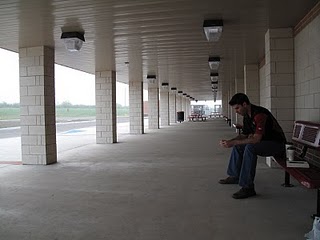BY NATHANIEL PARISH FLANNERY
In the thick yellow light of early evening, standing on the bluff next to the high school in the small Texas town of Roma, you can look out over the Rio Grande River and see into Miguel Alemán, the Mexican town on the other side of the border. Chase Whiting, a teacher at Roma’s Ramiro Barrera Middle School, who gave me a tour of the area in early March, told me that you used to be able to watch people hanging out and playing in the park on the other side of the river. I didn’t see anybody in the park and couldn’t see or hear any sign of activity in the town. The cartels and Mexican army have imposed a curfew on the town. Most people are home by six. “After 8 pm, anybody on the streets is fair game,” Whiting told me. At night you can hear the gunshots.
Aside from its proximity to the drug war, Roma is just like many other small US ranch towns. Route 83, the main drag that cuts through town, is dotted with shuttered grocery stores, vacant lots, taco stands, discount chain stores and dozens of signs advertising cheap loans and “EZ MONEY.” The used car lots mostly have a single row of cars in front that does little to hide the empty asphalt between the street and the salesrooms. Even the billboards are empty.
The Ramiro Barrera Middle School, which moved into a new building last year, is a meticulously maintained closed campus that contrasts sharply with the dusty, open neighborhood around it. On a side road, tucked away from Roma’s downtown district, the school seems distant from the town and even farther from the violence on the other side of the border. School administrators have fostered a culture of organization and accountability. On the one hand, students are barraged with constant encouragement to excel in their studies. But on the other hand, discipline is strictly enforced. Teachers stress the importance of helping students learn to make responsible choices.
White-and-green Border Patrol vehicles keep watch over the neighborhood surrounding the school. There are no broken windows or graffiti. Inside the building, students are marshaled between classes, overseen by security guards and cameras. The interior walls are plastered with inspirational quotations. Red digital clocks, which hang at fifty-foot intervals, prominently display the time for the students who walk the spotless red-white-and-gray tiled hallways. Tardiness is not tolerated.
While touring some of the local schools, I met Jose, a round-faced, polite eighth grader. I also met the school’s police officer, who took me to the in-school suspension room. There were seven kids seated in the room. “I’m surprised there are so many of you here,” the officer said. “You’re making us look bad.” Two of the girls were there for having rips in their jeans, and another was there for having painted nails–violations of the school’s dress code. Read the rest of the story in The Nation.
